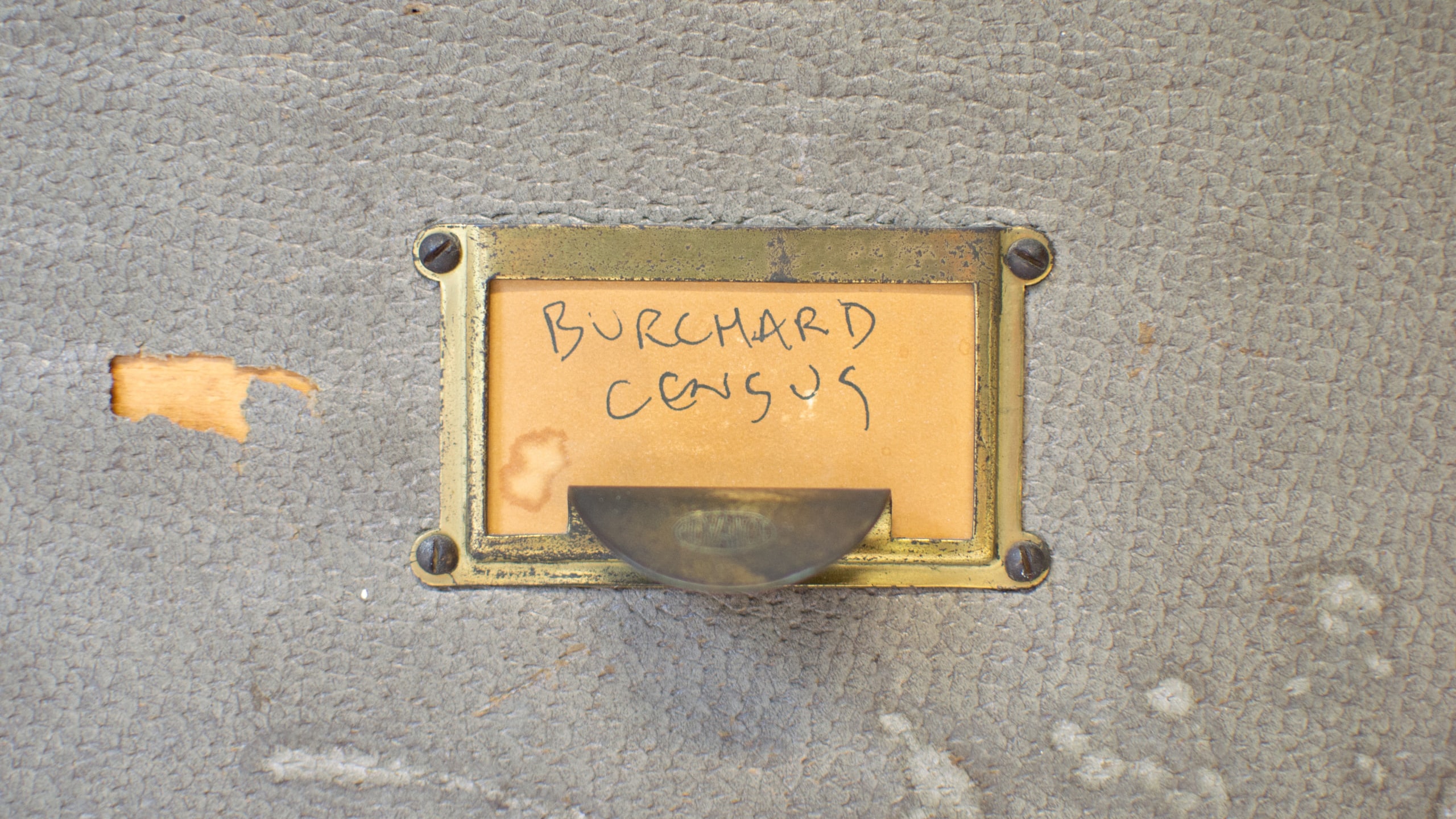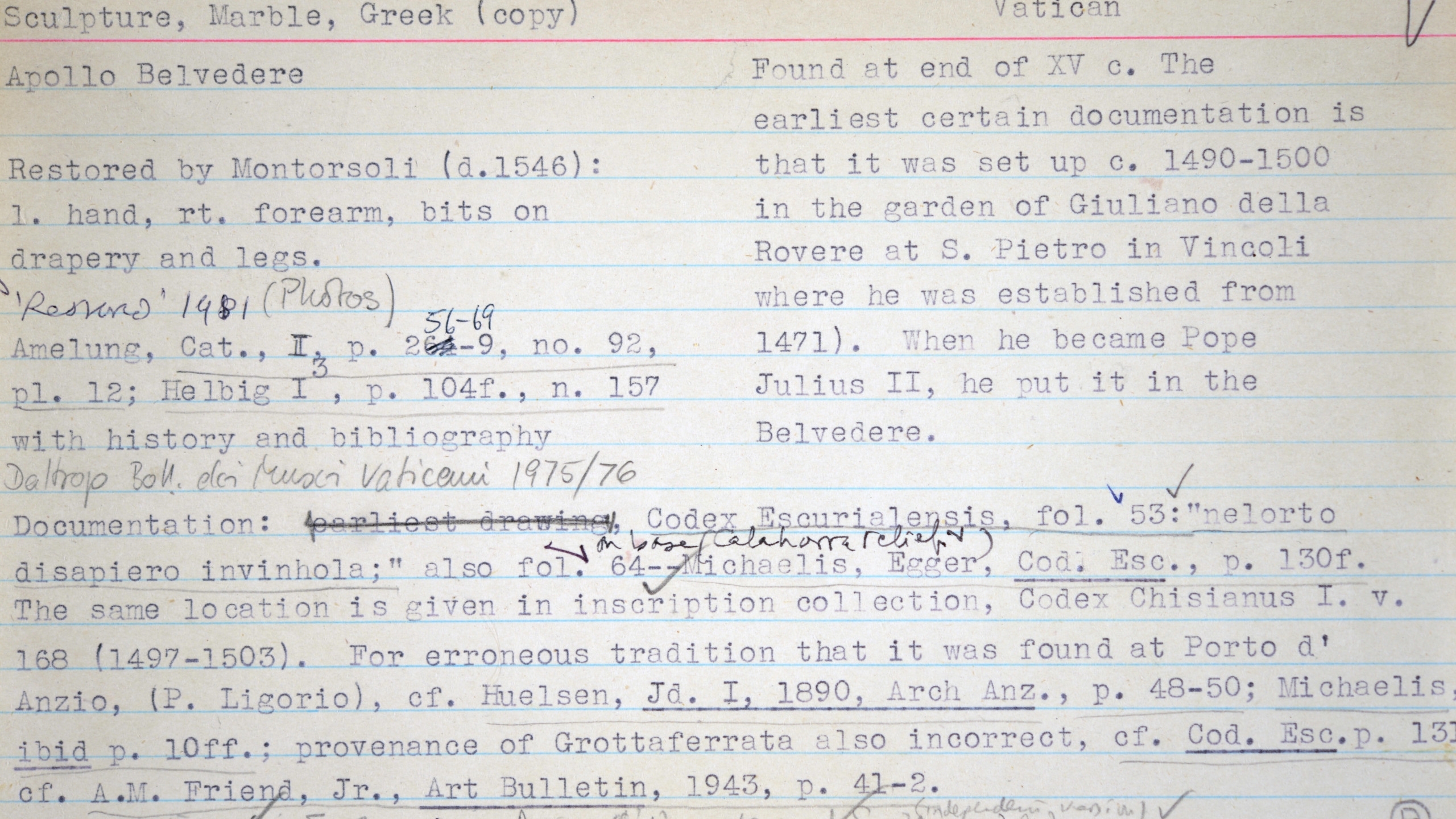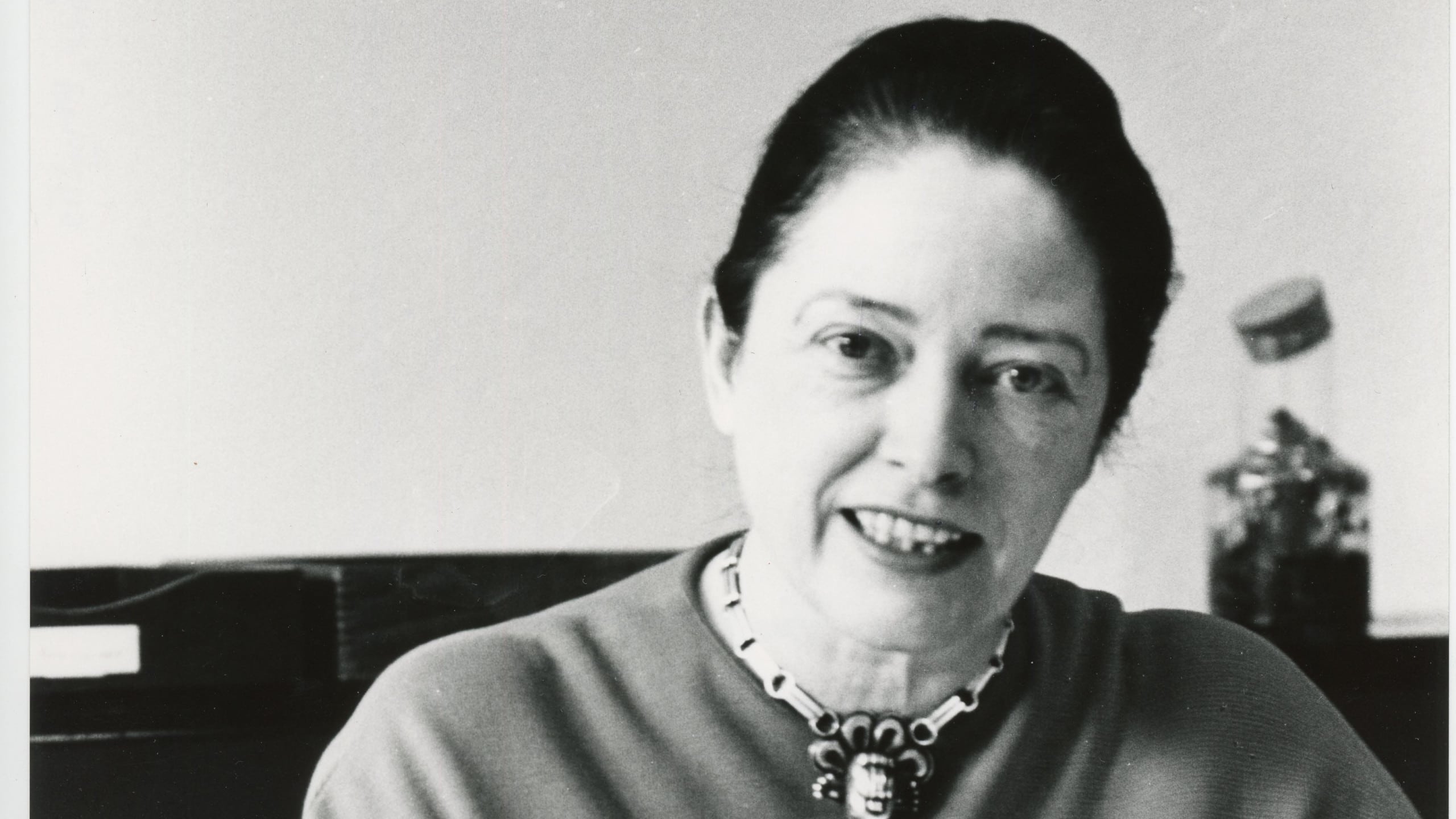75 Years, 1946–2021. From Index Cards to Online Database
Room 1
1940s. Burchard’s Box and the Birth of the Census
Already before the Census began, the German art historian Ludwig Burchard and his assistant Alfred Scharf gathered information on the knowledge of antiquity in the 16th- and 17th centuries using index cards. This room explores these cards and the early correspondence between Richard Krautheimer and Fritz Saxl about their ideas for a Census of Antiquities known in the Renaissance.
Room 2
1940s-70s. Bober and Rubinstein: Index Cards and Photographs
The Census became a reality when American archaeologist Phyllis Bober joined in 1947. Bober built and expanded the Census in collaboration with the Photographic Collection of the Warburg Institute, sending index cards to London where they would be matched with photographs. After 1957, she worked with her cross-Atlantic collaborator Ruth Rubinstein. This room explores their working methods.
Room 3
1981–3. Phyllis Bober and the Census Digitalisation
Phyllis Bober had since the 1940s developed the analogue version of the Census. How would she confront its digitisation in the 1980s? Letters from Bober’s archive in Bryn Mawr shed light on her contributions to the process.
Room 4
1980s-present. The Census Database
The database built in the 1980s has undergone numerous technological changes, while the content of the Census database has grown exponentially. This room includes a timeline of these developments and presents visualisations of the current contents of the database.
Census Timeline: 1945–2020s
1945
Richard Krautheimer, writing his monograph with Trude Krautheimer Hess on Lorenzo Ghiberti, suggests to Fritz Saxl, ‘Couldn’t we try to organize a corpus of antiques known to the 15th century?’ Saxl agrees to the idea, which he will develop it with Krautheimer during a trip to the USA in 1946.
1946
Krautheimer and Saxl begin to plan the Census. In a letter to Saxl of May, 1946, Krautheimer outlines the scope and aims of the project, which will gather literary sources and figural images. documenting antiquities known in the Renaissance. The project was from the beginning envisioned as a cooperation between New York University and the Warburg Institute, with both institutions keeping a copy of the Census in the form of duplicate index cards and (when possible) photographs.
1949–54
Work progresses as the Census becomes a formal project of the Warburg Institute with Phyllis Bober as its Director.
In 1954 NYU becomes a co-sponsor of the project and a base of operations for Bober.
Bober creates index cards for the Census, while the Warburg Institute Photographic Collection, under the direction of Enriquetta Frankfort, gathers photographic records.
1957–72
In 1957, Ruth Rubinstein assumes responsibility for the Census at the Warburg Photographic collection.
The cards and photographs continue to be compiled in two duplicate sets, one kept at the Warburg Institute and the other at NYU.

c. 1978
Michael Greenhalgh of Leicester University suggests that the Census should be computerised.
1981–84
In 1981, the Bibliotheca Hertziana joins the Census project, whose scope expands to include architectural material. The Census also extends its upper chronological limit to 1550.
Arnold Nesselrath is made director of the digitisation of the Census. Beginning in 1982 the Art History Information Program at the J. Paul Getty Foundation sponsors the computerisation of the Census at the Warburg Institute and at the Biblioteca Hertziana in Rome, funding the purchase of machines as well as software programming by Rick Holt.
Arnold Nesselrath follows Phyllis Bober as Director of the Census.

1986
Phyllis Bober and Ruth Rubinstein publish Renaissance Artists and Antique Sculpture: A Handbook of Sources, a reference book which disseminates the Census materials they had collected over decades.
1996
The Census moves to the Humboldt-Universität zu Berlin, where a professorship is created for the Director of the Census, first held by Arnold Nesselrath.

1996–2002
The project receives funding from the Bundesministerium für Bildung und Forschung.
2003–17
The project receives funding from the Berlin-Brandenburg Academy of Sciences and Humanities.
2020
Kathleen Christian was appointed professor at the Institut für Kunst- und Bildgeschichte and Director of the Census.
Bibliography
Bartsch, Tatjana (2008). Distinctae per locos schedulae non agglutinatae – Das Census-Datenmodell und seine Vorgänger, in: Pegasus. Berliner Beiträge zum Nachleben der Antike 10, pp. 223–260.
Bober, Harry (1962). The Gothic Tower and the Stork Club, in: Arts and Sciences: Ideas, Issues, and People in the University World, pp. 1–8.
Bober, Phyllis P. (1952). Letter to the Editor, in: The Art Bulletin 34, p. 253.
Bober, Phyllis P. (2002). Before and After the Census of Antique Works of Art and Architecture Known to Renaissance Artists, in: The Italian Renaissance in the Twentieth Century, edited by Allen J. Grieco, Michael Rocke and Fiorella Giofreddi Superbi, Florence, Leo S. Olkschki, pp. 375–385.
Bober, Phyllis P. (1963). The Census of Antique Works of Art Known to Renaissance Artists, in: Renaissance and Mannerism. Studies in Western Art, Vol. 2, pp. 82–9.
Bober, Phyllis P. (1977). The Coryciana and the Nymph Corycia, in: Journal of the Warburg and Courtauld Institutes 40, pp. 223–239.
Bober, Phyllis P. (1989). The Census of Antiquities Known to the Renaissance: Retrospective and Prospective, in: Roma, centro ideale della cultura dell’Antico nei secoli XV e XVI da Martino V al Sacco di Roma 1417–1527, edited by S. Danesi Squarzina. Milan, Electa: 372–381.
Bober, Phyllis P. (1995). A Life of Learning, in: American Council of Learned Societies Occasional Papers, 30.
Bober, Phyllis P. and R. Rubinstein (1986). Renaissance Artists and Antique Sculpture. A Handbook of Sources. London and Oxford, Harvey Miller Publishers and Oxford University Press. Revised edition published 2011.
McEwan, Dorothea (2012). Fritz Saxl. Eine Biografie: Aby Warburgs Bibliothekar und erster Direktor des Londoner Warburg Institutes. Vienna, Cologne, and Weimar, Böhlau Verlag.
Nesselrath, Arnold (1994). The Census of Antique Works of Art and Architecture Known to the Renaissance, in: Automatic Processing of Art History Data and Documents, Papers, vol. 2, edited by Laura Corti, Pisa, Scuola Normale Superiore, pp. 83–96.
Nesselrath, Arnold (1993). The Census of Antique Works of Art and Architecture Known to The Renaissance, in: Archeologia e calcolatori 4, pp. 23–27.
Nesselrath, Arnold (2015). The Afterlife of “Nachleben”. The Census of Antique Works of Art and Architecture Known in the Renaissance, in: The Afterlife of the Kulturwissenschaftliche Bibliothek Warburg, edited by Uwe Fleckner and Peter Mack (Vorträge aus dem Warburg-Haus 12), Berlin, De Gruyter, pp. 187–199, 245–247.
Nijkamp, Lieneke, Koen Bulckens and Prisma Valkeneers (eds.) (2015). Picturing Ludwig Burchard 1886–1960: a Rubens Scholar in Art-Historiographical Perspective, Harvey Miller.
Rubinstein, Ruth (1984). The Census of Antique Works of Art Known in the Renaissance, in: Colloquio sul riempiego dei sarcofagi romani nel medioevo, Pisa 5.–12. September 1982, edited by Bernard Andreae and Salvatore Settis, Marburg/Lahn: Verlag des kunstgeschichtlichen Seminars, pp. 289–290.
Trapp, Joseph B. (1999). The Census: its Past, its Present and its Future, in: Pegasus. Berliner Beiträge zum Nachleben der Antike 1, pp. 11–21.
Exhibition Organisers
Seminar participants and exhibition organisers: Kathleen Christian (Humboldt-Universität, seminar convener); Ioana Dumitrescu, Emily La Vay, Christopher Lu, Antonia Rosso, Zahra Syed (MA students, Warburg Institute); Pia Ambrosius, Agnete Bay, Ariana Binzer, Tim Boroewitsch, Leonie Engel, Marie Erfurt, Friedrich Fetzer, Marina Goldinstein, Helene Hellmich, Eva Karl, Matteo Anthony Kramer, Anna Latzko, Sarah Letzel, Maria Elisabeth Lehmann, Ayami Mori, X. Tuan Pham, Valentina Plotnikova, Leetice Posa, Claire-Elisa Rüffer, Lucy Salmon, Hannah Sommer, Sophie Steiner, Lidia Strauch, Elisa Tinterri, Radu Vasilache, Bahar Yerushan, Zhichun Xu (BA students, Humboldt-Universität zu Berlin).
Acknowledgements
This exhibition was created as a collaboration between the Humboldt-Universität zu Berlin and the Warburg Institute in London by BA students in art history in Berlin and MA students in London. It developed out of a seminar taught online by Kathleen Christian at the Humbolt-Universität during pandemic restrictions in the Winter semester of 2020–21. It could not have taken place without the great generosity of many people who joined the seminar for interviews on Zoom, who provided access to archival materials and photographs, or in many other ways offered their insight and invaluable assistance. In particular, the organisers would like to thank the following (in alphabetical order): Daan Bachman, Jonathan Bober, Horst Bredekamp, Rembrandt Duits, Franz Engel, Meral Karacaoglan, Simon Kwauka, Elizabeth McGrath, Eckard Marchand, Jennifer Montagu, Luise Mörke, Arnold Nesselrath, Lieneke Nijkamp, Caspar Pearson, Martin Price, Ursula Price, Eric Pumroy, Clara Sawatzki, Bill Sherman, Paul Taylor, and Claudia Wedepohl.
Drawings: Bahar Yerushan
Web Design: stark.marketing Heidelberg



